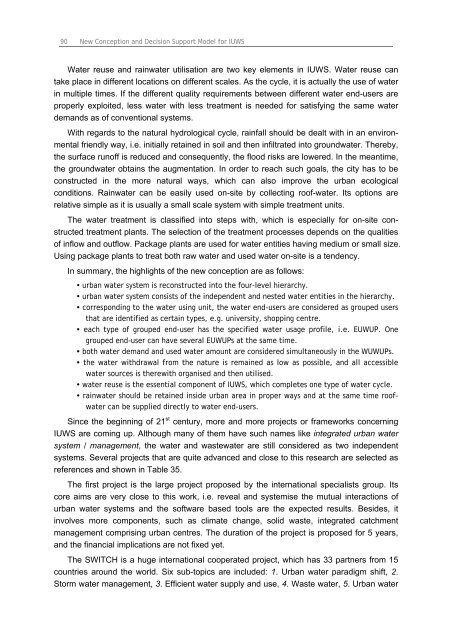Chapter 3 Decision Support Model (IUWS-DSM) - Tubdok
Chapter 3 Decision Support Model (IUWS-DSM) - Tubdok
Chapter 3 Decision Support Model (IUWS-DSM) - Tubdok
Create successful ePaper yourself
Turn your PDF publications into a flip-book with our unique Google optimized e-Paper software.
90 New Conception and <strong>Decision</strong> <strong>Support</strong> <strong>Model</strong> for <strong>IUWS</strong><br />
Water reuse and rainwater utilisation are two key elements in <strong>IUWS</strong>. Water reuse can<br />
take place in different locations on different scales. As the cycle, it is actually the use of water<br />
in multiple times. If the different quality requirements between different water end-users are<br />
properly exploited, less water with less treatment is needed for satisfying the same water<br />
demands as of conventional systems.<br />
With regards to the natural hydrological cycle, rainfall should be dealt with in an environmental<br />
friendly way, i.e. initially retained in soil and then infiltrated into groundwater. Thereby,<br />
the surface runoff is reduced and consequently, the flood risks are lowered. In the meantime,<br />
the groundwater obtains the augmentation. In order to reach such goals, the city has to be<br />
constructed in the more natural ways, which can also improve the urban ecological<br />
conditions. Rainwater can be easily used on-site by collecting roof-water. Its options are<br />
relative simple as it is usually a small scale system with simple treatment units.<br />
The water treatment is classified into steps with, which is especially for on-site constructed<br />
treatment plants. The selection of the treatment processes depends on the qualities<br />
of inflow and outflow. Package plants are used for water entities having medium or small size.<br />
Using package plants to treat both raw water and used water on-site is a tendency.<br />
In summary, the highlights of the new conception are as follows:<br />
� urban water system is reconstructed into the four-level hierarchy.<br />
� urban water system consists of the independent and nested water entities in the hierarchy.<br />
� corresponding to the water using unit, the water end-users are considered as grouped users<br />
that are identified as certain types, e.g. university, shopping centre.<br />
� each type of grouped end-user has the specified water usage profile, i.e. EUWUP. One<br />
grouped end-user can have several EUWUPs at the same time.<br />
� both water demand and used water amount are considered simultaneously in the WUWUPs.<br />
� the water withdrawal from the nature is remained as low as possible, and all accessible<br />
water sources is therewith organised and then utilised.<br />
� water reuse is the essential component of <strong>IUWS</strong>, which completes one type of water cycle.<br />
� rainwater should be retained inside urban area in proper ways and at the same time roofwater<br />
can be supplied directly to water end-users.<br />
Since the beginning of 21 st century, more and more projects or frameworks concerning<br />
<strong>IUWS</strong> are coming up. Although many of them have such names like integrated urban water<br />
system / management, the water and wastewater are still considered as two independent<br />
systems. Several projects that are quite advanced and close to this research are selected as<br />
references and shown in Table 35.<br />
The first project is the large project proposed by the international specialists group. Its<br />
core aims are very close to this work, i.e. reveal and systemise the mutual interactions of<br />
urban water systems and the software based tools are the expected results. Besides, it<br />
involves more components, such as climate change, solid waste, integrated catchment<br />
management comprising urban centres. The duration of the project is proposed for 5 years,<br />
and the financial implications are not fixed yet.<br />
The SWITCH is a huge international cooperated project, which has 33 partners from 15<br />
countries around the world. Six sub-topics are included: 1. Urban water paradigm shift, 2.<br />
Storm water management, 3. Efficient water supply and use, 4. Waste water, 5. Urban water

















